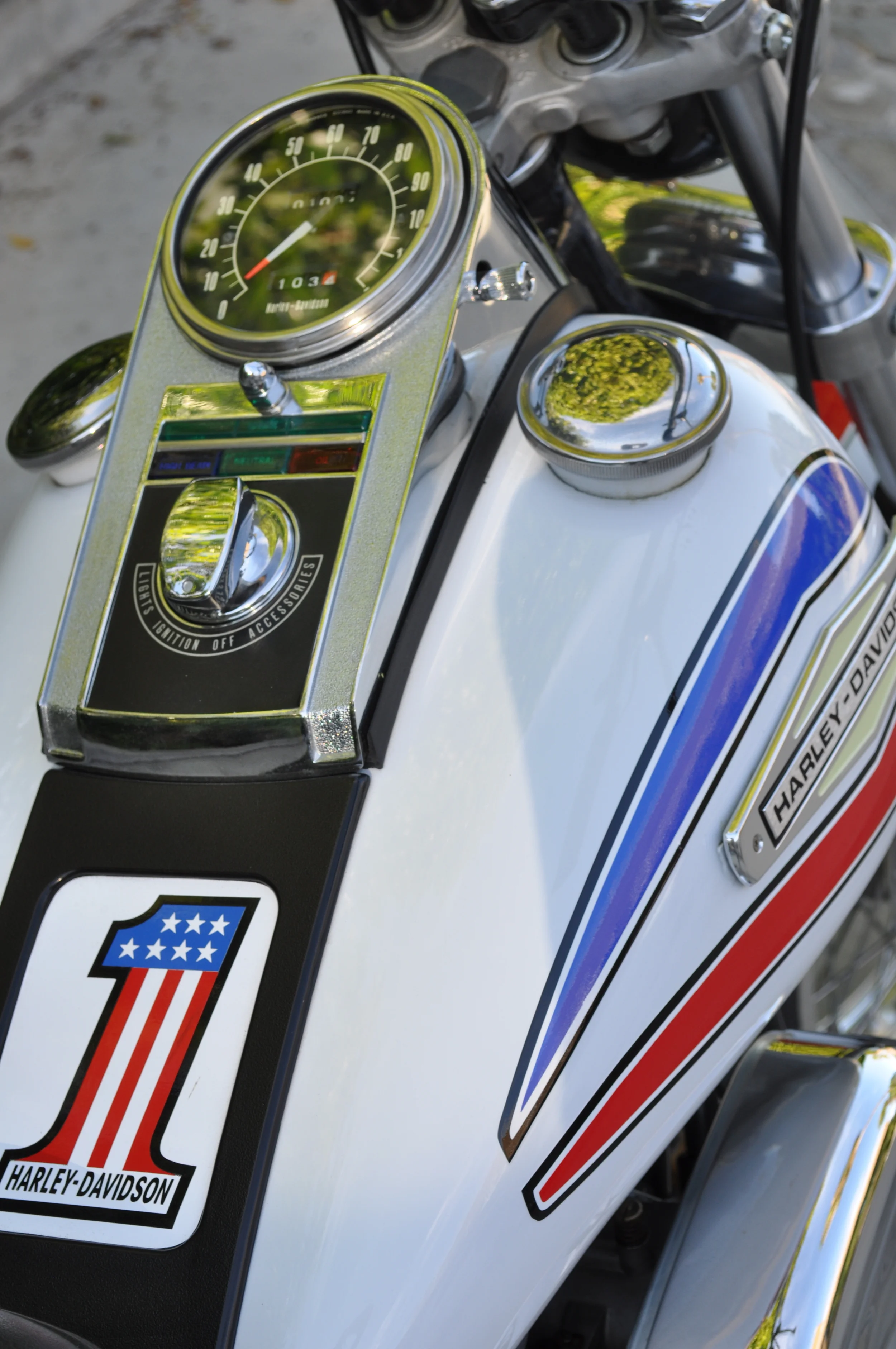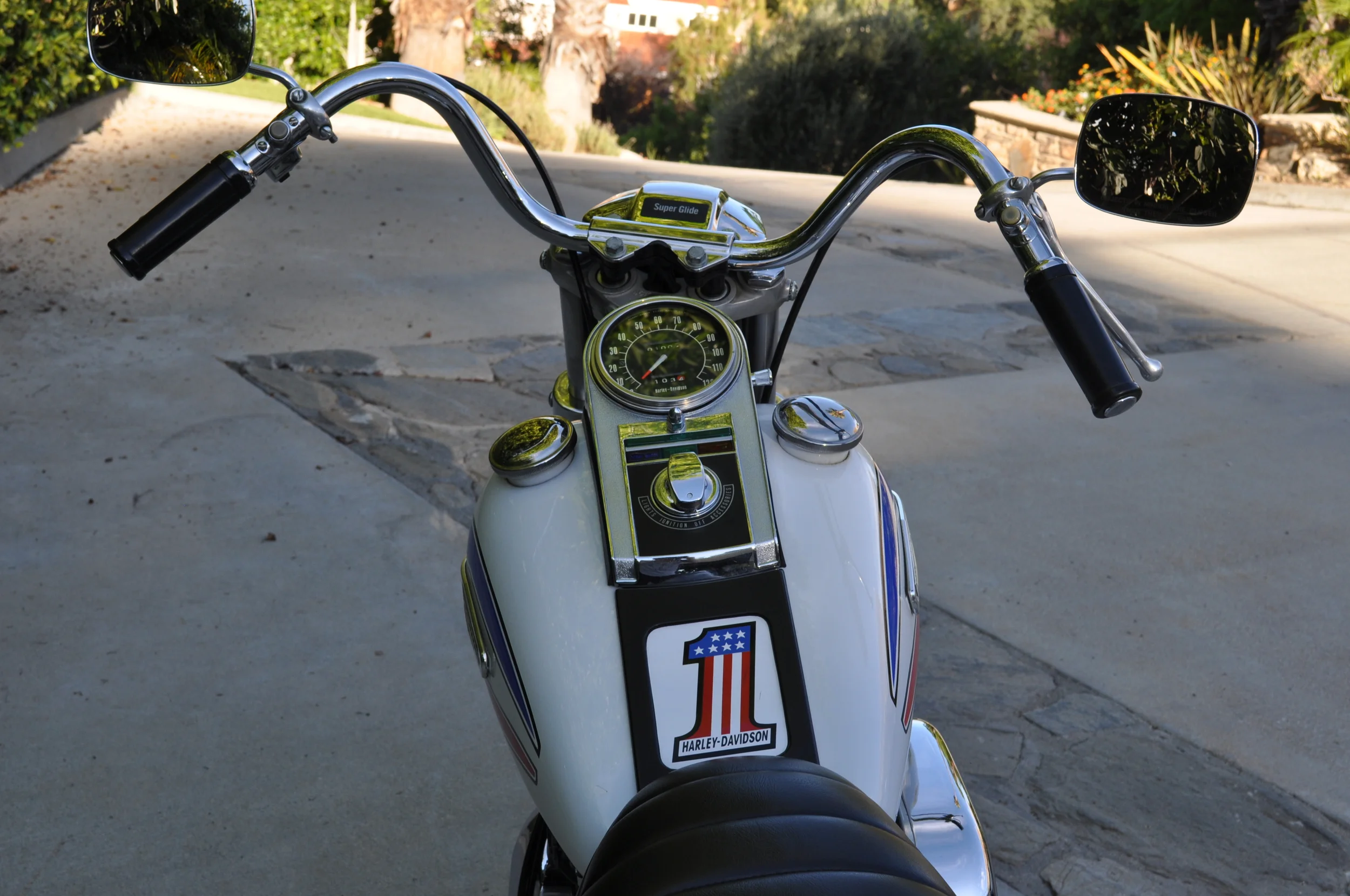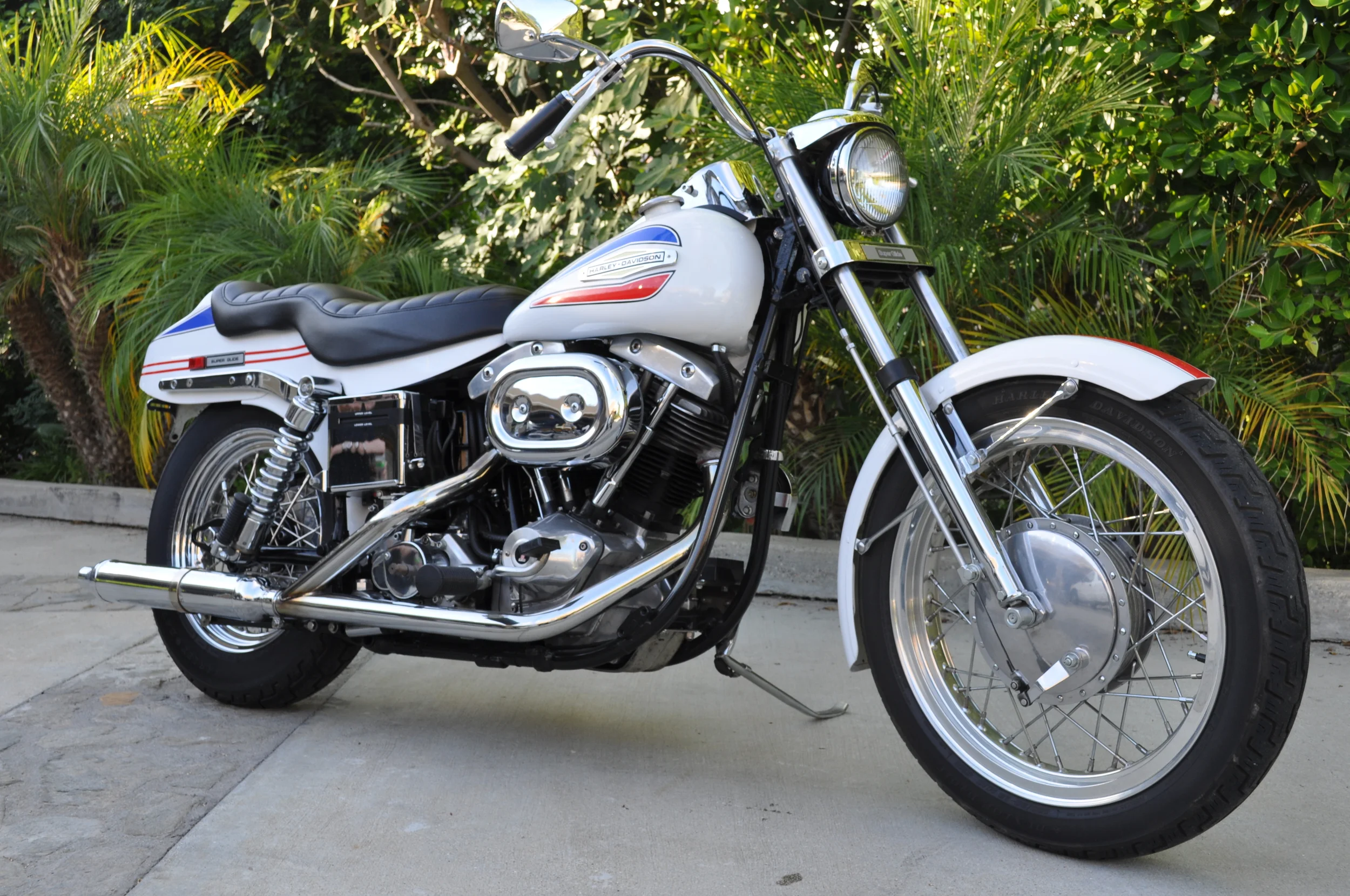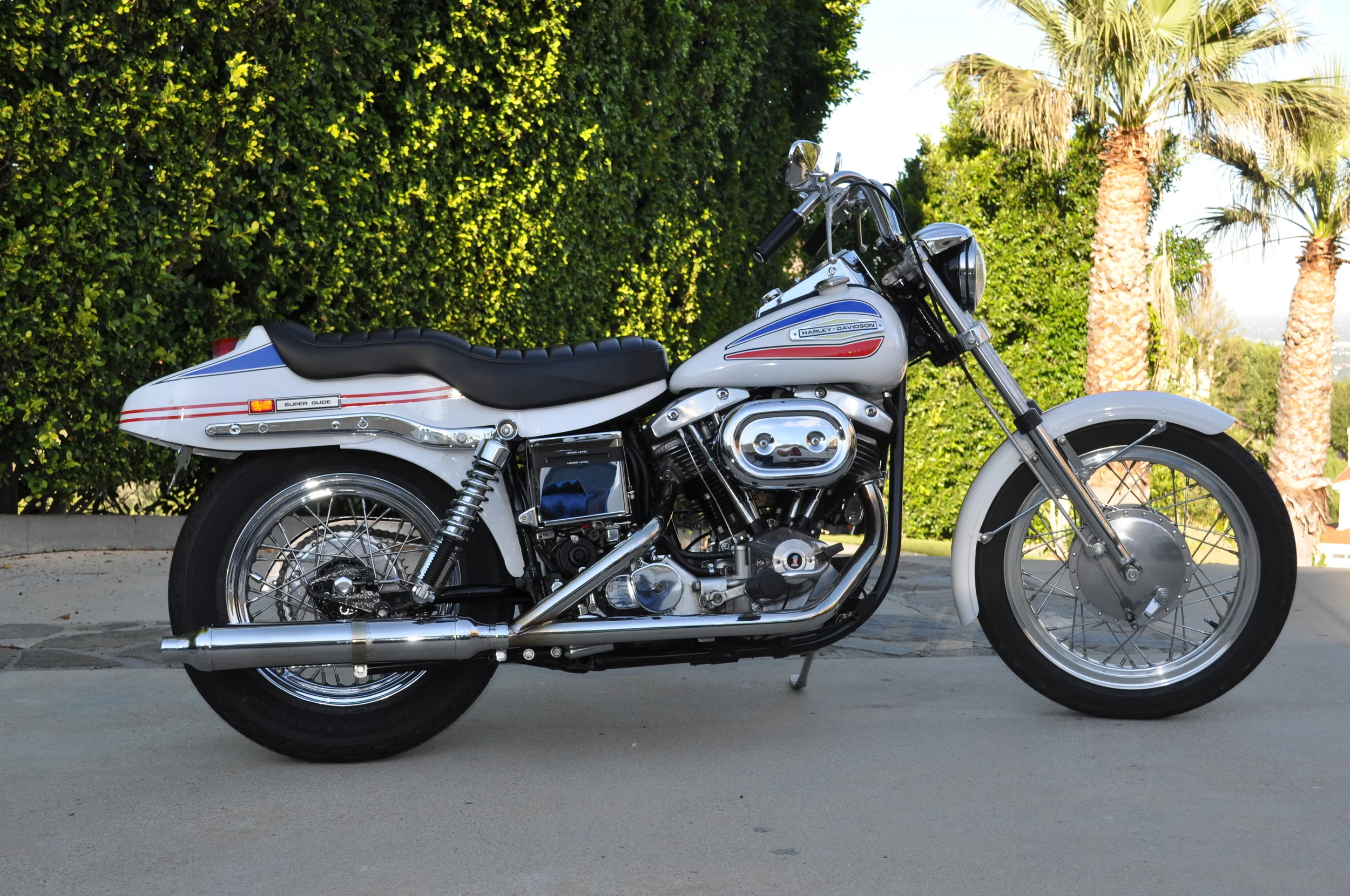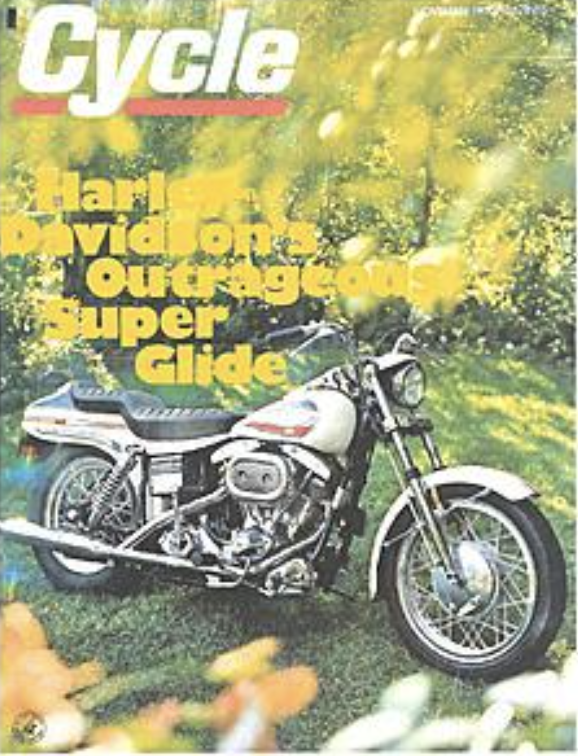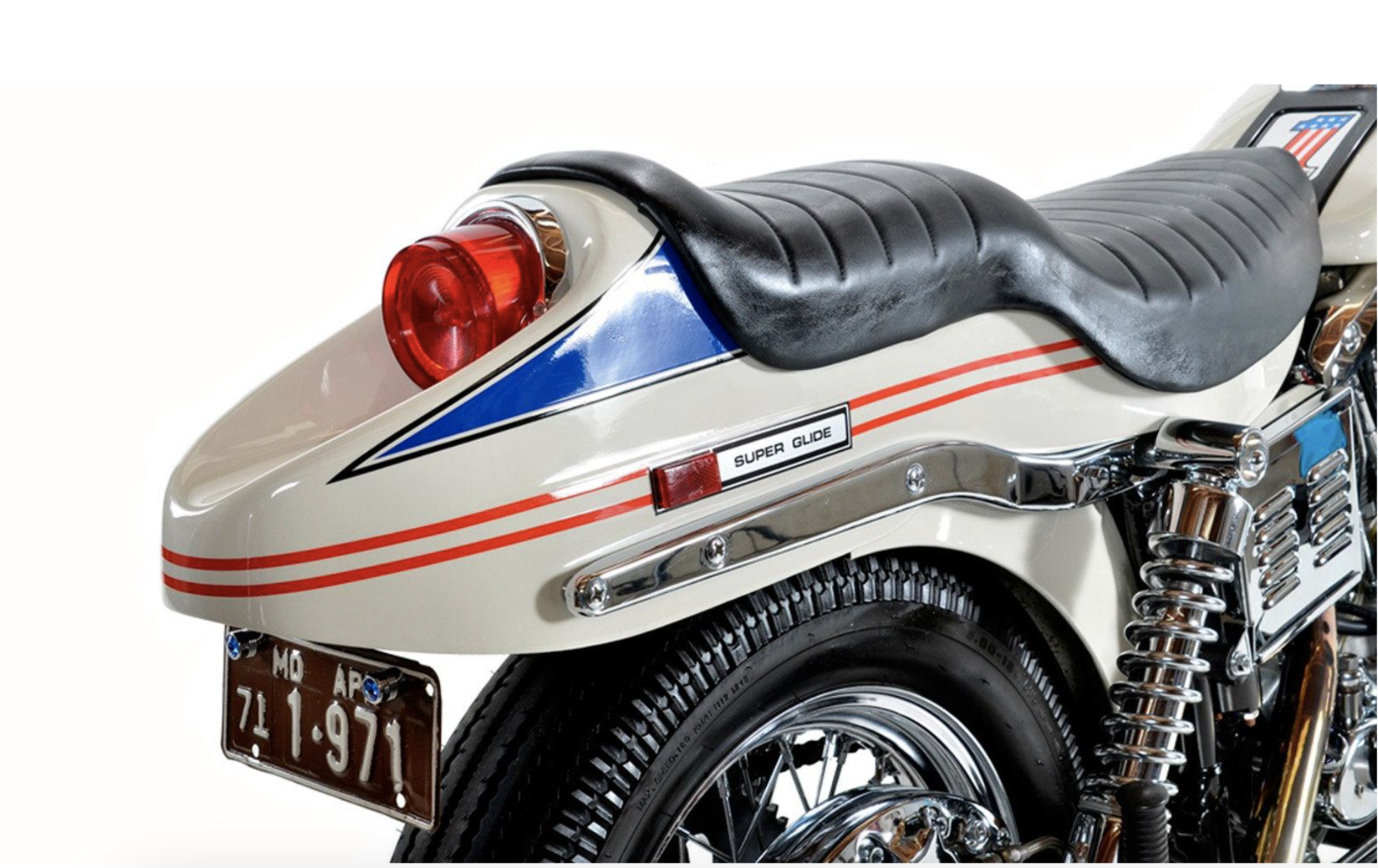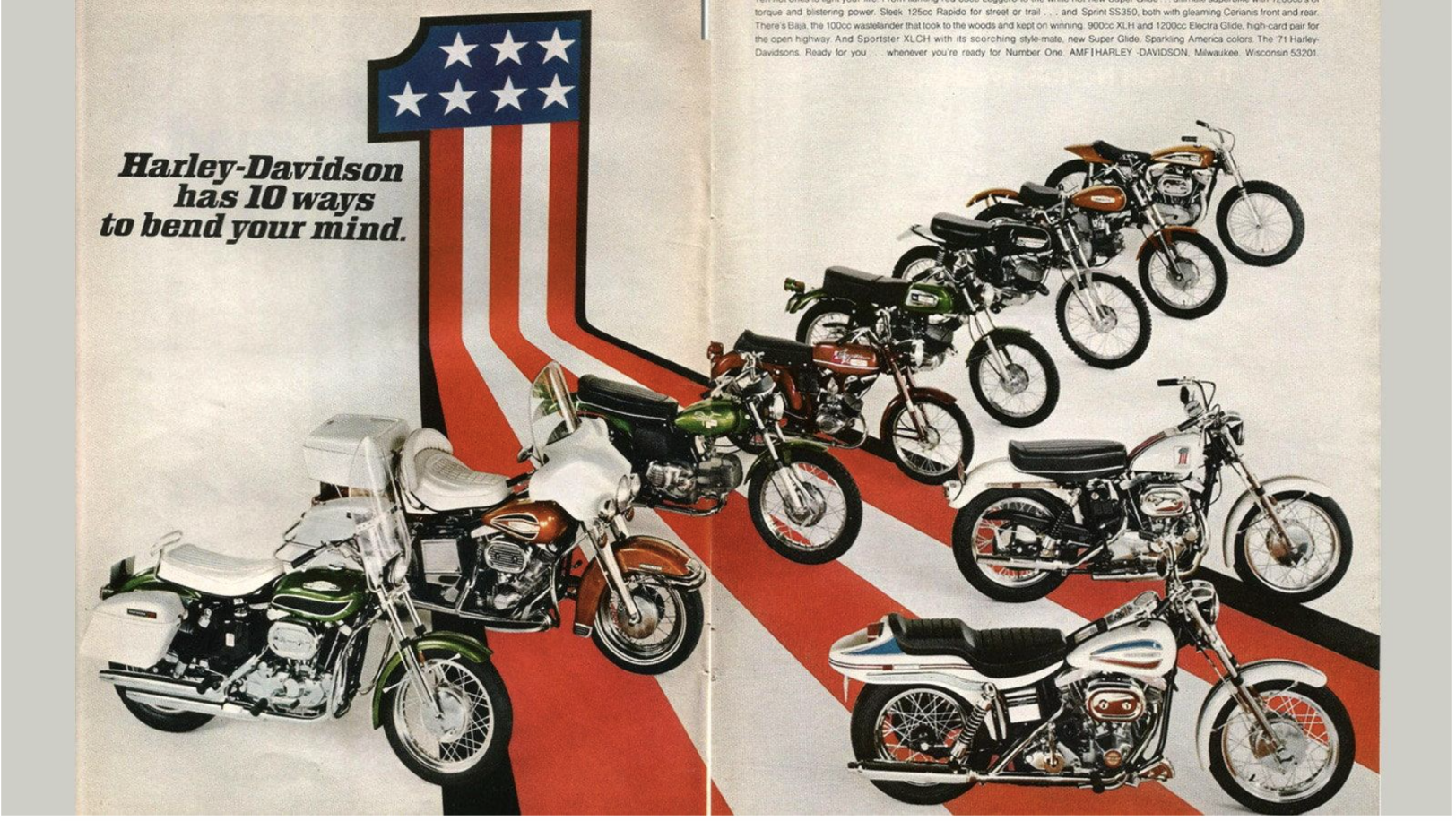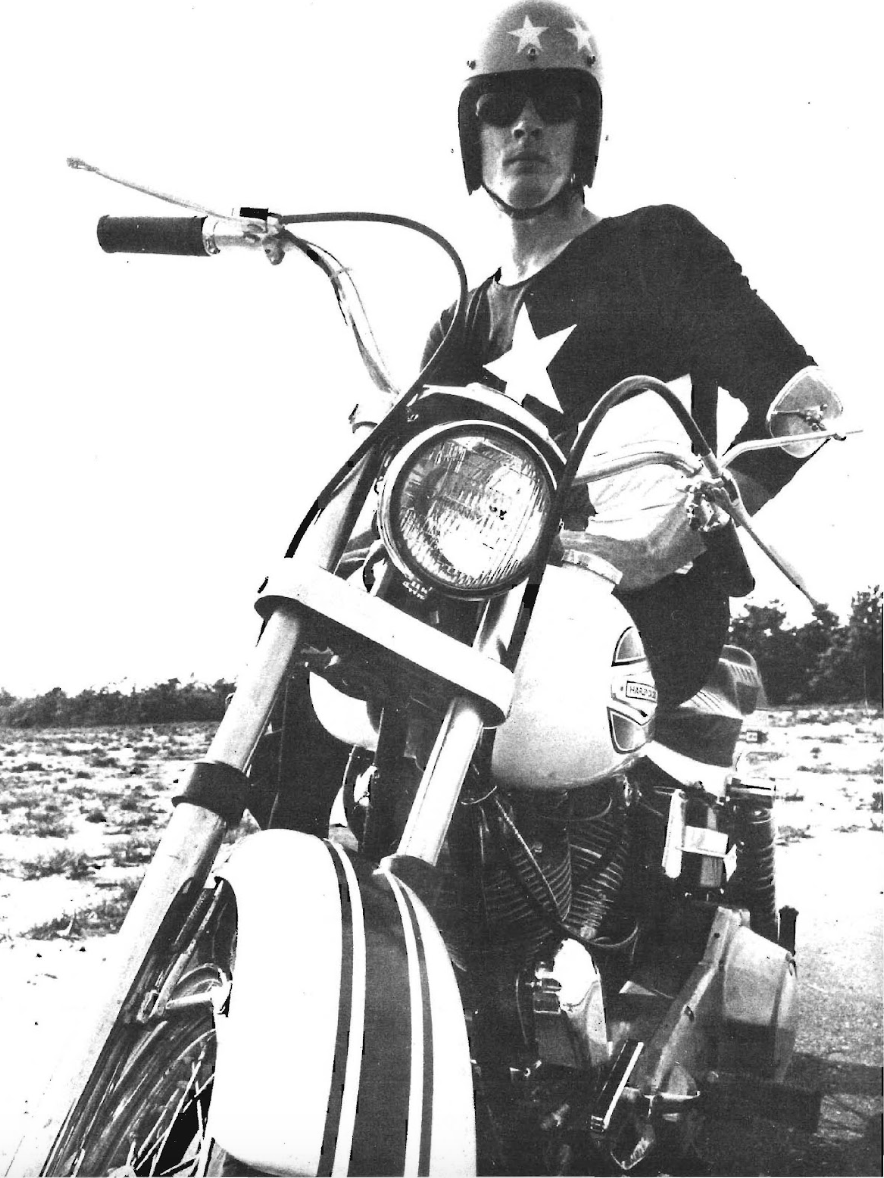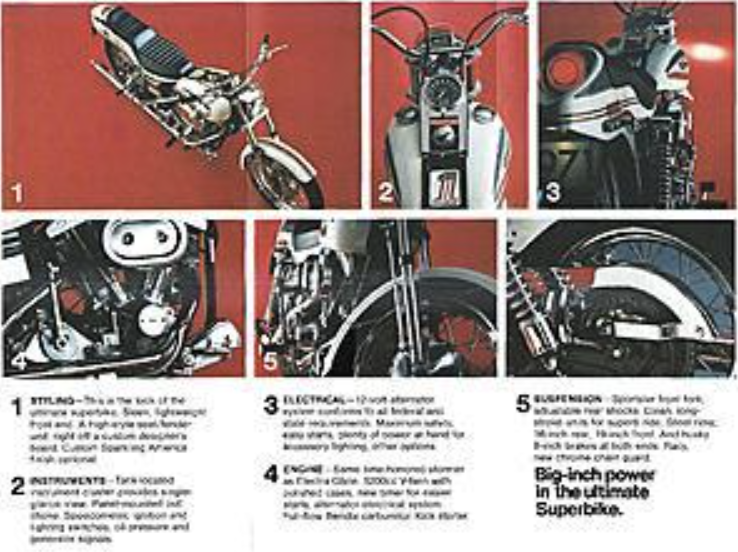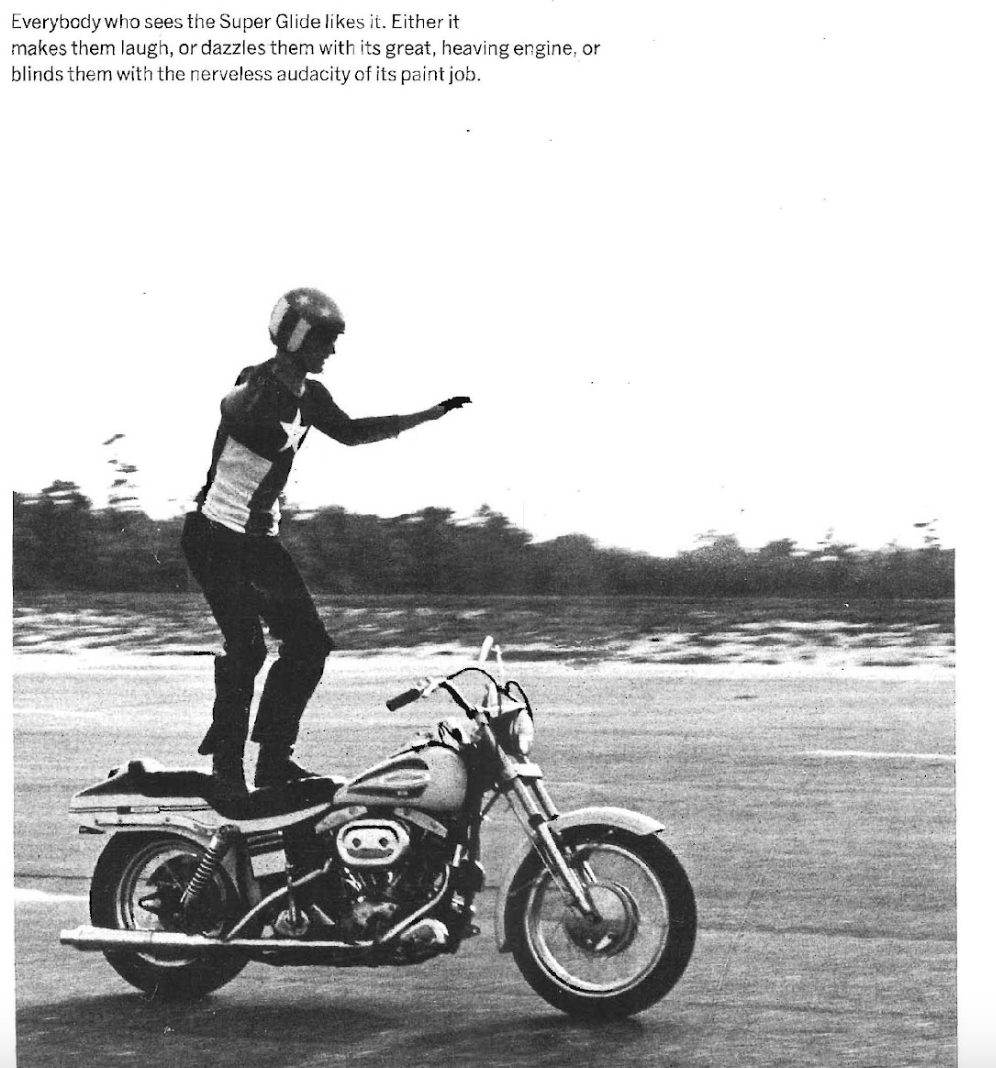1971 Harley Davidson FX Super Glide – Sparkling America Edition
In the fall of 1970 I turned 16 years old. My most significant psychological job at that point in my life was to determine how to become a man. In the process of learning to become a man we want both to be normal, that is like other men, but to also learn how to become a man who is unique and true to himself. In order to do this, I had to decide on which traits I had to build up and make a consistent part of my personality and character and which tendencies to chop away and discourage. In this way we all sculpt our unique and individual identity. Carl Jung, Sigmund Freud’s contemporary in psychiatry called this process individuation. This process of individuation is not just for our psychological development, but also very importantly as a way of attracting members of the opposite sex. You want to be normal enough to not be scary and but different enough to be interesting and exciting.
In addition, women have always taken an interest in men with power and mobility. Prior to the Industrial Revolution and the development of the internal combustion engine, power and mobility had to do with mammalian modes of transportation. So one can imagine in ancient Greece one lady saying to another lady: “did you see young Aristotle today on his magnificent stallion! I’ve heard he has five of them in his stable”! Since the beginning of the 20th century comments about men’s horses turned to comments about men’s vehicles and their horsepower. In high school I remember overhearing girl’s conversations of guys they found attractive. Frequently, they would talk about a date in the following way: “Steve picked me up to go to the Big Boy in is really cool dark blue GTO!” Therefore, it occurred to me very quickly in my process of individuation, that there was real power in having a uniquely desirable vehicle to take a lovely young lady to paradise. Certainly for me this was part of the process, although to be honest just owning and driving and appreciating the beauty of the vehicle was equally important.
It was in this psychological setting that I first saw a 1971 Harley Davidson FX Super Glide. It was in a magazine ad. I remember it quite vividly. In the lower half was a picture of a motorcycle- the styling of which I had never seen before. It almost looked like a “chopper” of the era with lean chromed fork tubes extending far out in front the bike. The motor and frame looks like a typical big-engine Harley-Davidson. But the seat was enveloped in a cowling that seemed to flow organically from the tip and curve of the front fender, along the rounded contours of the classic Harley-Davidson gas tank and then streaming backwards across the top of the rear wheel/fender to create an amazing visual line of power and speed. The picture shows the Super Glide motorcycle parked in front of a diner at night. The bike is seductively illuminated by a streetlamp from above. In the background one can see the establishment through the lighted windows with patrons inside. On the steps outside, dimly lit in the background, is a young attractive female and her male companion who is holding a white motorcycle helmet and is clearly the owner of the Super Glide. His right leg is extended and touching her right leg while his right hand holds her’s. He is looking intently and suggestively into her eyes. Very interestingly, she is not looking at him but gazes out at the bike. The suggestion is that they had just met in the establishment as she does not have a helmet. It appears that as she gazes at the Super Glide, she’s in the process of making a decision.
As discussed earlier, perhaps she is considering if he is both normal and different enough and what does his choice of vehicle suggest about this question. The ad copy at the bottom says the following “Super Glide FX – call it the Night Train! New 1200 cc Super Glide FX -The ultimate superbike. The action eager muscle machine that says Move Out… One look tells you... You are the man for this hot new muscle machine- Super Glide FX – The Night Train! This ad could not be more suggestive of what ownership of this motorcycle could do for the individuation of a young man – not to mention other benefits!
After seeing this advertisement, I had to go see it in person. On a Saturday afternoon, after doing some grocery pickup for my mother, I drove to the local Harley-Davidson dealership before returning home. The moment I walked in a salesman immediately asked me if I was old enough to buy a motorcycle. I pulled out my driver’s license with the “M” endorsement on the back. He started showing me the least expensive offerings of Harley-Davidson, the Sportster. After briefly looking at the Sportsters, I asked him about the new Super Glide. He said “oh yes I do – and wait till you see it!” He took me back to the secondary showroom area which was away from the natural sunlight coming through the front windows. The salesman said “we only keep the special bikes back here!”
There, lit under a spotlight type lamp, much like the picture in the advertisement, was a brand spanking new Super Glide FX – The Night Train! They had cordoned the bike off by surrounding it with movie theater style velvet ropes and posts. A sign threateningly said “DO NOT TOUCH.” It was painted in brilliant white with red and blue striping. A large Harley-Davidson Number One decal lay on the top of the tank. This was the $40 optional “Sparkling America” paint scheme. It was simply glorious!
Entering the secondary showroom my first viewing of the bike was from the rear. Looking along the left rear of the bike was the huge chrome primary cover and to the right was the “double barrel” shotgun exhaust aiming back at me. Instead of the traditional fender wrapping all the way over the top and halfway down the back of the rear wheel and tire, the rear cowling came across the top with a circular red tail light in the middle. As I approached the motorcycle from the right rear the overwhelming desire to mount to this steed gave me the courage to ask the salesman if I could sit on the bike. He hesitated and then asked if I could afford such an expensive machine. I asked how much it was and he responded that it was about $2700 out the door. Swallowing the sticker shock, I answered a different question by saying “well, I have my own landscaping business”. This was true in that I mowed a number of lawns in my neighborhood. I was able to get the work by stuffing mailboxes with mimeographed advertisements that said “Phil’s Landscaping-I will mow your lawn for less money and do a great job”. That didn’t answer the question as to whether I could afford the price of the bike but seemed to satisfy the salesman and he said “okay, hop on her-but be careful. That’s a man’s machine!”
Getting on this hot new muscle machine seemed like losing my virginity! Approaching from the left rear I swung my right leg up and over the stepped seat and settled into the seat. I felt like I was sitting more in the bike than on it. The bike was leaned on to its left side stand with the wheel cocked over to the left. I grabbed the handgrips and straightened the bike, leaning the it to the right underneath me and couldn’t believe the sheer weight of the Super Glide compared to previous bikes I had experienced. The Buckhorn bars lifted my arms up and out as I look straight out over the kicked out front end. Given that the biggest bike I had sat on previously was a Triumph 650, this bike was in every way almost twice as massive.
I knew that ownership of such a bike was beyond a dream. But for a few moments of reverie I imagined riding down a long stretch of open road with a lady behind me, her arms snugly wrapping around my waist, after we had just left some establishment like the one in the advertisement. Then I heard a voice- “young man, young man!” – The salesman was saying as I came out of my dream. “So what do you think? Are you ready to buy it?” I deployed the side stand and leaned the bike back over on its left side and cocked the wheel back over to the left. I would not sit on another Harley-Davidson Super Glide FX until I purchased one for myself 40 years later.
The history of the development of the 1971 Super Glide is quite fascinating. Next to the Big Twin FL and the Sportster XL, the Super Glide custom line has been the longest Harley product line in existence. The Super Glide would evolve into a wide variety of forms carrying the FX badging which exists to this day almost 50 years later. If it were not for the 1960s, the FX would likely have never existed. At the beginning of the 1960s Harley was flush with success. The major competition in the United States, Indian Motorcycles, stop production in 1953. In the heavyweight and touring category, no significant foreign competition existed between 1953 and 1969.
In 1960 Harley purchased controlling interest in Aermacchi to take advantage of their light weight motorcycle line. This was done to compete with the burgeoning demand for entry-level and lightweight motorcycles. Through the 1960s the Aermacchi lightweights the Harley lineup but could not effectively compete with the onslaught from Honda, Yamaha, Kawasaki, and Suzuki motorcycles in terms of cost and quality. In addition, the Japanese makers seem to have better advertising firms especially with the example of the Honda ads that proclaimed “you meet the nicest people on a Honda”. Harley was still having to fight the image of its association with the hooligan biker groups made infamous at Hollister in 1947 and the movie “The Wild One” in 1953. Much like the Beatles, whose light shone so brightly in the early and mid-1960s, and then flamed out by 1969, Harley followed suit. In the early 1960s, Harley and motorcycles were practically synonymous in the United States. They were winning road racing championships and flat track dirt bike championships, dominating at every level. However, Cal Rayborn’s victory at the Daytona 200 on a specially prepared KR model, would be Harley-Davidson’s last street bike victory. The company had become bloated and top-heavy and to prevent a corporate takeover Harley Davidson was sold to another “leisure product” company called AMF Corporation.
AMF Corporation recognized that the central products of the Harley Davidson company were the heavy street bikes, the FL’s and the XL’s. They also realized with the introduction in 1969 of the paradigm shifting Honda CB 750 that in order to compete they had to do something with their core street bike lineup. This is where Willie G Davidson, the grandson of founder William Davidson, enters into the history as the director of styling for Harley-Davidson. AMF approached Willie G and asked him to come up with a custom motorcycle that would bring some of the elements of the strong custom motorcycle scene together into a factory custom. But AMF put some limitations on Willie G. Apparently they said you can use anything available from any of the bikes currently in production as well as anything from the fiberglass production plant used in the golf cart manufacturing company that AMF acquired as part of their purchase of Harley-Davidson.
So Willie went back to California (he had graduated from the Pasadena Art Center College of Design before joining Harley-Davidson in 1963) to look at all the custom Harleys that were being put together by shops up and down the West Coast. He talked to many of the leading customizers. In the late 60s and early 70s the customized Harley look was that of an extended fork chopper. There were also shorter extended fork versions known as dragsters because they mimicked quarter-mile drag race bikes. They all shared one thing in common. This common theme was the removal of the heavy and wide front end and its replacement with a slim front fork and a taller and skinnier front wheel and tire combination. Willie was also reportedly influenced by European styling such as the rear cowling of the 1968 Norton fastback which put the seat into a fiberglass constructed cowling from the rear of the gas tank and extending to envelop the rear tail light. This styling also eliminated part of the rear fender that allowed for the rear tire to be more fully visible, similar to the choppers and bobbers he was seeing in the custom scene. Willie utilized the fiberglass molding capabilities of the golf cart company to manufacture this rear cowling and it was dubbed the “boat tail”. The factory boat tail rear cowling was actually available on Sportsters from late 1969 through 1971 before the Super Glide was created.
Willie G continued to work through 1969 and 70 on the design of the FX model. His initial focus was on the front end design described earlier. The simplest solution was to bolt the very lovely and light sportster front onto the FX frame. Amazingly, the transformation was astounding. It made the bike look lighter, faster, and more nimble-and it was! An added bonus was the use of the smaller and more custom appearing front headlamp from the Sportster. He then reengineered the mold used for the Sportster boat tail for a similar look on the bigger FX frame. One of the problems they encountered was the huge right side battery box, present on all FL models since 1965. It just did not look good with the boat tail cowling. So they made a smaller battery box and removed the electric starter as well, apparently concerned about not having the amperage necessary for starting. Finally, they needed a red, federally DOT approved tail light lens. They pulled one off in 1965 Chevrolet Biscayne I worked perfectly. Apparently, they received the legal okay to use it from Chevrolet. And that put the final touches on the final design of the structure and mechanicals of the FX model. Incidentally, the FX has been deemed to be so named using two different possibilities. One is that the X stands for experimental. The other is that the F is for the FL part and the X is for the XL part. Take your pick-or both.
The next step was deciding on a paint scheme as well as how to market the machine. The United States was in the midst of the war in Vietnam and all the divisiveness associated with it. He wanted to please their traditional hawkish customers as well as young people who were against the war. The board of Harley-Davidson knew that the custom/chopper image that the FX model was designed around could evoke many potential negative emotions due to its association with both the 1% biker clubs as well as with pot smoking hippies like the characters on the recently released Easy Rider movie. It would’ve been interesting to be a fly on the wall of those marketing and board meetings. Nevertheless, the end result was the famous sparkling America paint job, white base with red and blue prominent striping. They also used the famous number one Harley logo design featuring a large number one in red white and blue with the name Harley-Davidson as the bottom. This had been designed earlier in 1970 by an unnamed Harley-Davidson employee after their recent Grand National racing victory led by Mert Lawill. They put this logo framed in a cover on top of the split gas tanks in front of the seat. The red white and blue American flag paint scheme and the American flag number one logo satisfied the America – love it or leave it crowd. This group also thought the red white and blue Evil Knievel paint schemes may have been a template. The factory custom chopper-like styling as well as the possible linkage to the red white and blue featured on the Captain America chopper in the Easy Rider movie satisfied the antiwar group. Even though the Super Glide came in multiple colors, the bike was widely marketed in magazine ads mainly in the Sparkling America paint version. In addition to the ad copy that I described earlier the prominent use of the description “All American Freedom Machine!” was used.
The bike was introduced to its dealers in 1970 and available to the public in the fall of 1970 as a 1971 model. The MSRP was $2190. The sparkling American paint scheme would cost you an additional $40. The 1971 Harley-Davidson Super Glide FX was met with mixed sales success. The majority, but not all, of the 4700 purchasers did not like the boat tail but liked the rest of the look and feel of this motorcycle. Many of the boat tails were stripped off and custom frame fitted seats were applied before the motorcycles ever left the dealership. Many of these now valuable (some NOS units reportedly selling on eBay for $3000 plus) boat tails were thrown in dumpsters or occasionally up into the rafters for storage to be sold in lots decades later. The other big negatives were the absence of electric starting and a front disc brake. Virtually all the competition in the heavyweight class had electric starting by 1971 for all the usual reasons. As I described in my early encounter with this motorcycle in the fall of 1970, I loved the new style!
But by 1973 the complaints about the boat tail, lack of electric starting and a front disc brake resulted in all of these being changed. The 1973 FXE had a frame hugging seat, electric starting, and a front disc brake with a smaller and more custom gas tank. This was the bike that really started to sell for Harley-Davidson. It went on to become the low rider of 1977 and the Sturgis model of 1981, and all of the subsequent FX based models into the current day. Harley really had something when Willie G designed this bike.
Given all the above, when I had the ability to go out and find a Super Glide FX of my own I did so. I found an original, numbers correct example that needed the usual sorting out. For this particular machine I decided not to be a purist and make it into a true rideable machine. I had the engine rebuilt by a Harley master mechanic. It now has an OEM electric start from the FL models of the day. I changed the crazy bell crank type setups used for the original shifter and rear brake for direct linked ones as used in later models. I also remove the original seat that was made from some unknown synthetic material (likely the result of an error at Dow Chemical) which was hard and uncomfortable and cracked within the first year of use for most people. I put that in storage. I had my upholstery guru make up a seat that looks extremely close to the original but actually has some comfortable foam in it making long rides comfortable. I changed the reproduction rear hub and wheel assembly that came with the purchase to an OEM Harley unit. I also changed the primary chain to a belt drive. As most people know, especially with the “cone motor” Harley engines, the biggest oil leaks tend to come from the primary case which is eliminated going to belt drive. In addition, the drive train is that much smoother and quieter. For better front braking I ensured that the drum was trued and arced the best brake shoe linings to the drum. It definitely helped!
The resulting ride on this motorcycle is everything I anticipated when I first sat on that first Super Glide under the spot lights at age 16. Compared to the big twin FL bikes of the era which weighed about 700 pounds, the 565-pound wet weight (1/2 tank of gas) of the FX results in much better performance in every way. It is still no canyon carver, but is much more responsive leaning into turns. On the straightaways the 65 foot-pounds of torque really allow for pleasant and even exciting acceleration. I’ll never forget the November 1970 Cycle Magazine feature article that I believe was written by Cook Nielsen, the magazine’s editor. I’ll quote some of his comments that did then and still do now capture the essence of this bike. Nielsen wrote the following:
Regarding the first visual experience of the FX: “everybody who sees the Super Glide likes it. Either it makes them laugh, or dazzles them with its great, heaving engine, or blinds them with the nervous audacity of its paint job”
Regarding Its Straight-Line Performance: “the bike was extremely easy to ride straight on the strip, and extremely tough to ride crisply. The 1st to 2nd shift was a bit complicated… by the slop in the shifter linkage.”
Regarding the brakes: “the brakes are an abomination, unworthy of the Super Glide. The bike flies. The bike handles. The bike will not stop.… The Super Glide lists for a solid $700 more than a Honda 750… Harley Davidson could have become competitive with the imports in this very crucial area. They didn’t.”
Regarding how the Super Glide makes you feel: “what does the bike do for you? How do you feel when you ride it? You feel like a damn King is how you feel; everybody is looking at you, admiring the waves of bravado that flood off the exterior of the Super Glide, digging the bongo beat rhythm of the engine. The Super Glide is turned out for a parade; subtlety never makes it in a parade, And Subtlety Dares Not Exist on the Super Glide.”
Summarizing the Super Glide: “the Super Glide faces you brazenly: it is what it is – massive bolts attaching massive appurtenances to a massive frame and a seat configuration that stretches over the horizon, the whole issue propelled along by an enthusiastic engine neither having nor wanting any excuses. It is terribly self-conscious, terribly extreme; it leaves itself no outs, brooks no compromises. It starts easily, runs well, doesn’t leak oil, will not break, and handles more than adequately. Visually, like it or not, the Super Glide is a dazzler, and Harley-Davidson’s commitment is a dazzling commitment. With the exception of the sickening failure of the brakes, the Super Glide is everything mechanically that it promises visually to be; and it will succeed in this country like no machine Harley Davidson has ever made or dreamed of making.”
In hindsight, that kind of writing and that kind of motor journalism was pretty phenomenal. In addition, the prediction of the significance of this motorcycle, this first factory custom for Harley-Davidson, was spot on!
To this day, when I take this gorgeous machine for a ride, I cannot help but to be taken back to the age of 16, when I first was thrilled to be able to sit on my first Super Glide. It reminds me of the job I had to do at that time psychologically, which was to individuate and become the best man I could be. This job required that I become a man with the virtue of being a solid and reliable performer in the marketplace, in society, and with my family and my friends. Equally importantly, to brook no compromise in the most important issues of my life and to be true to myself. The 1971 Harley-Davidson Super Glide FX became a significant factor in the Harley-Davidson company of becoming a solid and reliable performer in their marketplace while also being true to themselves!


